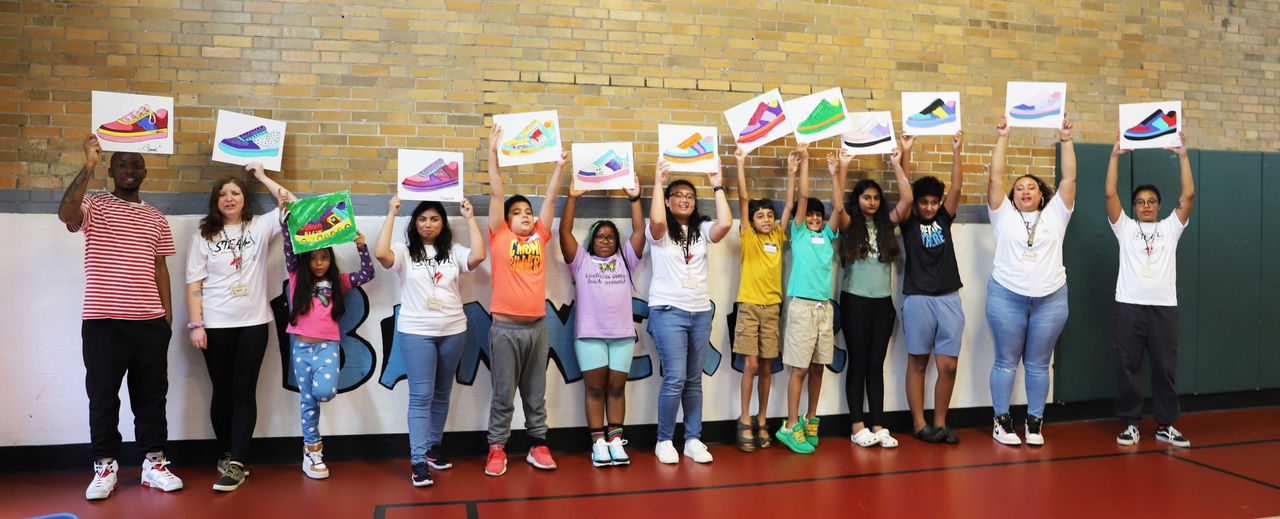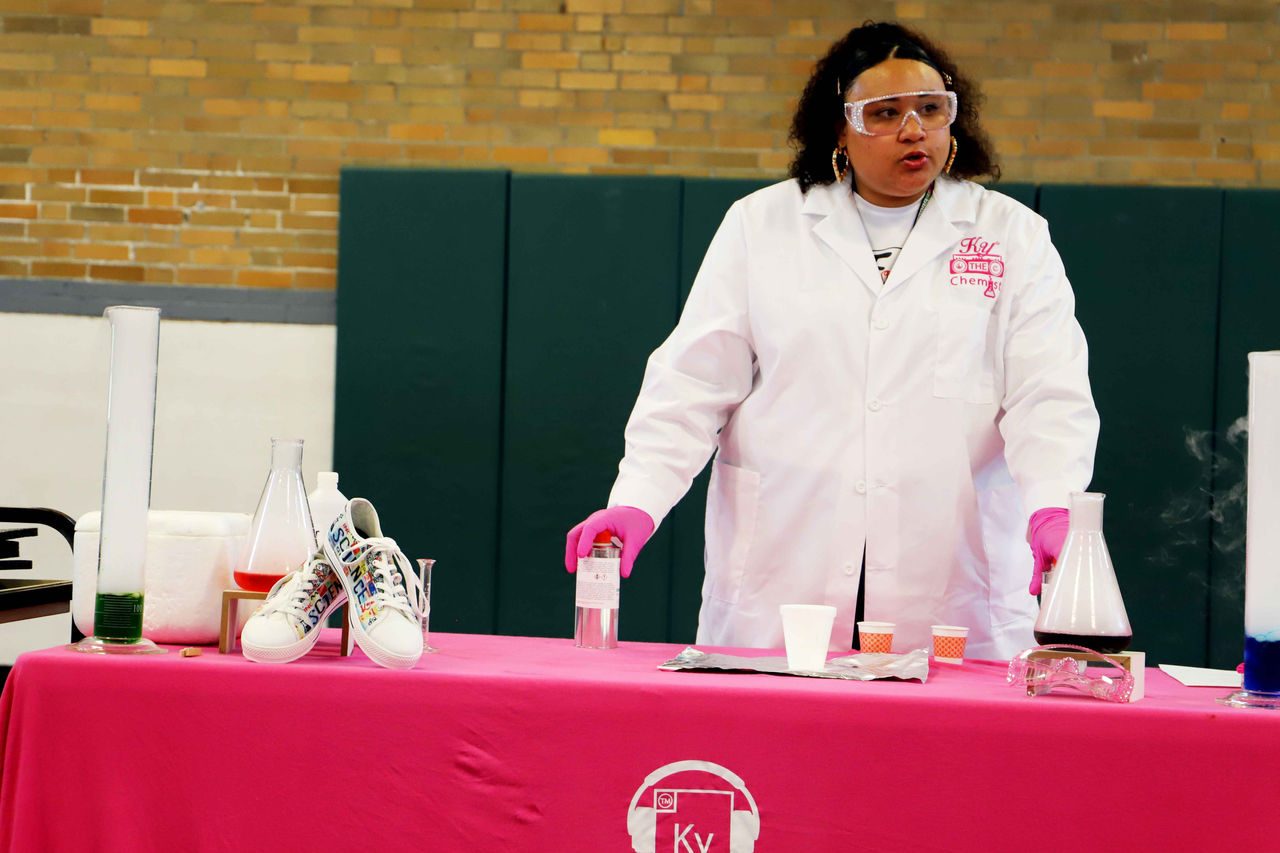Jakyra Simpson hesitates to call herself a sneakerhead, an enthusiast who collects and trades sneakers. “Do I have good sneakers in my closet? Heck yeah,” says Simpson, who recently graduated from Indiana University with an MS in chemical biology. Her favorites are a pair of Off-White Air Jordan 4’s, but she concedes that there are other sneakerheads who have a deeper passion for collecting, wearing, showing off, and trading all kinds of kicks, from classics to rare and limited editions to new releases. “There are people who are for real for real. I'm an intro to intermediate level.”
Don’t let that humbleness fool you. Simpson knows her stuff, especially on a scientific level. In fact, she’s on a mission to glorify sneakers in a way that few sneakerheads dare to with STEAM SneakerheadzTM, her Science, Technology, Engineering, Arts, and Math (STEAM) education business that teaches chemistry and art through hip-hop culture.
STEAM SneakerheadzTM holds workshops where kids learn about the chemistry of materials used in sneakers. Kids receive a large outline of a sneaker, with empty regions corresponding to each different material. They learn about the leather “uppers,” rubber soles, and other parts. They even get to make their own rubber for the sneaker art.
Simpson founded the company while in grad school. Soon after starting grad school, she started mulling over ideas to improve chemistry outreach with topics that a more diverse set of kids could connect with. The idea, and the prospect of connecting with a more like-minded community of chemists and educators, was exciting—especially at a time when she was struggling to muster the same excitement for her nanoparticle research project. “I'm having these thoughts at home that this is the work that I really want to do,” Simpson says. “But I'm showing up every day doing something I don't want to do.”
So she took the leap. The new idea blended her love of hip-hop, chemistry, and art. It just felt right: “I realized that I'm talking about sneakers—that covers polymer chemistry, materials chemistry, analytical chemistry, environmental chemistry, general chemistry,” she says. “I was like, Oh, snap. This is it—this is the one!”
She pitched it to her mentors and advisers, and it took shape.
Simpson has long searched for more inclusive chemistry outreach that embraces her Black and Filipino heritage. “I've been the only person of color in my classrooms,” she says. “I had a hard time feeling like I could even relate to the material, because a lot of the stuff was about White people. So I’d just think, what other contributions in science have been made by people that look like me?” Now, she hopes her new venture will provide that answer for many chemists and students to come.

You faced resistance when first pitching this idea to mentors early on. When did that change?
My lab specialized in nanoparticles, and it just wasn't for me. I was in my second semester of school, and I had been doing stuff that wasn't making me happy—and grad school is already hard.
I was an ACS Bridge fellow, so I reached out to the Bridge Program and asked if there was flexibility for me to explore this. I said: I have an idea. It's still chemistry, but it kind of tackles outreach and chemistry education. The [ACS Bridge] director told me that as long as whatever I’m pursuing has a hint of chemistry in it, I have full creative ability. When I heard that, I said, Oh, y'all messed up now!*
So I mustered up the courage to vocalize my opinions to my mentor, Dr. Yan Yu.
How did that conversation go?
That was a really hard conversation for me. I told her the truth: “I'm really struggling to connect with your research. I really want to work with you, but I want to do my own project.”
She took a moment. She paused and asked me to tell her about the project. I came in prepared! I told her I want to do some type of sneaker education. I see myself doing some type of artwork, with hands-on activities. Not only was she willing to support me, even though she told me she doesn't know anything about hip-hop or sneaker culture, but she was willing to learn from me. She expressed that for the last 3 years she had been teaching a chemistry class through art. Nobody in our lab even knew.
How did things change after you got the green light?
I had a chance to go to BCCE, the Biennial Conference on Chemical Education, at Purdue in 2022. That opportunity was everything I needed it to be. Because while I was there, I realized that the work that I'm doing is chemistry education. I made contacts, and people gave me resources, and I learned about the journal that we have, ACS Journal of Chemical Education.
There were people of color presenting on the importance of having culturally relevant information and teaching things to implement in our education system. I realized talking to other teachers that this could be put together as a package to train other educators. It just made me even more excited and involved in the idea.
And I'm just like, wow—because this is not only something that I've dealt with, it's something that I've created a potential solution for. From there, I put together my first activity last October at something called Science Fest. It was a hit. Kids were loving it.
Being able to talk to kids about sneakers and chemistry, everyone scratches their head—and I love that effect. I love it. Because a lot of people don't realize the overlap.
It seems that you made the right decision for yourself.
I am still open to a PhD, and actually I’m going to apply next month. But for the work I’m doing, it’s not a requirement.
I would like to show people you can be successful with a master’s, but I also have recently learned about all of the opportunities available if I do get a PhD. Regardless, it will be in a program that allows me to focus on my STEAM education, incorporating sneaker culture.

What’s a typical STEAM Sneakerheadz workshop like?
Usually I recruit high school students, or I'll recruit college students, to help me to facilitate the workshops.
I have two different versions, a weekend version, where you come in for a 4- to 5-hour mini lesson, and a weekly version with 1.5- or 2-hour sessions. For the weekend sessions, I make ethylene-vinyl acetate copolymer foam and then let the kids pass it around. They choose which foam they want to use for the artwork, so it's a combination of education and hands-on activities where kids can make something.
Do the kids get to make any sneaker materials?
With rubber soles, we talk about the chemistry. Then the kids make a rubber solution from latex and make thin sheets and cut them out to fit onto the canvas artwork. They can customize the rubber sole however they want, like adding glitter. It has to cure for 24 hours, so the next week, I bring in all these pieces for the artwork.
I mainly use this lesson to introduce how rubber is created naturally, [I explain the difference between] vulcanized versus unvulcanized rubber, and the application of rubber soles and other places where rubber is used in multiple industries. I really want to make sure that I’m connecting the dots for students on a big scale.
What’s your favorite part of sneaker chemistry to explain?
I've really been liking my polyurethane demos. I make the polyurethane foam and let them touch it and play with it. During the demo you start out with a small Styrofoam cup and two liquids that you mix together. But as it expands it turns into a foam dome. They're always like, “whaaat”!
With most of the kids being younger, they’re just really fascinated by the fact that I even create the foam, and watching the process as it grows. I also do not convert this into a fabric. I show this chemical demo as an example of what polyurethane foam looks like and then introduce the application to sneakers and how polyurethane is used as a fake leather. Most kids and even adults have never seen polyurethane to even connect it as a foam and/or fabric found in shoes.
I teach them how not only that it is used for the mid-soles in our sneakers, but polyurethane also gets added to synthetic leathers—that’s how polyurethane fabrics are made.
Then, I have a lesson where I teach kids about sustainability. There are fabrics nowadays that are being made to address environmental issues. There’s this one called Piñatex. It looks like leather, but it's made out of pineapple leaves. I got like a big swatch of it and let the kids pass it around. Sneakers contribute a lot to wastes that are in landfills.
You mentioned having trouble finding your community in academic chemistry, and noticing the huge lack of relatable outreach. What do you think drew you to chemistry?
In high school, I just remember that chemistry made sense to me. Chemistry is everywhere. All fields connect to the real world in their own ways, but with chemistry I could learn this foundation and I could literally apply it anywhere. Also, I loved Bill Nye the Science Guy. I would love to have a Ky the Chemist show. I would have a hip-hop spin to it to talk about the chemistry in different aspects of hip-hop culture.
What did you learn from your experience of going to work every day knowing it’s not what you want to do?
The importance of advocating for myself. I realized school is a choice, I am choosing to be here. I choose to come into this lab. And it got to a point where something's gotta give. I felt very isolated because there were few people of color in my department. At the same time as I was advocating for myself academically, that's when I also started to find my community outside of my department.
Do you have advice for having hard conversations with your mentors or supervisors?
Have ‘em. If you don’t keep asking for things you want, you're going to get nowhere. In my department, there were only like four Black people, and two of them were graduating. I didn't want my actions interpreted as the “angry Black woman” just because I'm trying to fight for my way. But the worst thing someone's going to do is tell me no. It took me a while to get comfortable with that. Having my idea formulated really helped me.
What has most surprised you on your journey?
I surprised myself. In the beginning, when I presented this to other colleagues and other people in the department, they told me they didn't understand it—that it didn't make sense, and I should pursue something else. I almost feel like I was the black sheep. Even though I was in graduate school, the place where you're supposed to be able to explore your own projects. I'm resilient. So I kept sticking it out. And to go from that to the conference to having something that's done and putting it out in the communities—that's the biggest surprise.
So how did the recent workshop go?
I did a survey at the start, and half the kids told me that they love science, but they don't like art. The other half of the kids told me that they like art, but they hate science. And by the end of my workshop, every kid was grinning ear to ear. For me, that's what made me happy.
*A lighthearted expression in black culture to convey an intention to progress and show gratitude for encouragement one has received. Translation: “Oh, you better watch out because I'm about to take this positivity and run with it!”



